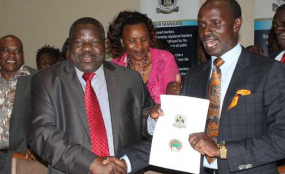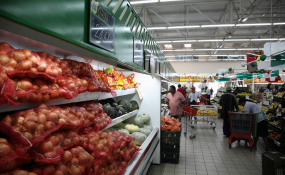By Mark Egan
As operations manager at a South African platinum mine, Percy French has faced huge challenges over the past few years because of volatility in commodity prices. The price of platinum has dropped in half, and at the same time the value of the South African currency, the rand, has fallen precipitously. To keep his mine profitable, French had to look for new ways to make it more efficient. He found sensors and software. “We cannot afford any loss of revenues from inefficiencies because our cost to refine one ounce of platinum remains the same even though we get paid half of what we used to,” French says.
French’s company, Lonmin Plc, about an hour’s drive from Pretoria, is the world’s third-largest platinum producer. The process of refining platinum works like this. Once the ore has been crushed and turned into dust, furnaces heat the concentrated powder to over 1,500 Celsius and blow air through it to remove iron and sulfur impurities. This helps to shrink its mass before the refining process. A mix of chemicals and heat are repeatedly applied to the ore until eventually you get pure platinum, which is used in everything from automotive catalytic converters to jewelry and computer hard disks. It can take up to six months and 7 to 12 tons of ore, put through several complex physical and chemical processes, to create one troy ounce (31.1 grams) of platinum, now valued at about $930.
Lonmin’s operations were suffering from bottlenecks, French says. Downtime in the drying area of the smelter sometimes caused the whole production line to come to a standstill, resulting in the platinum being ruined. “If we lose one hour of availability, that costs us roughly 1.72 million rand per stoppage,” French says.
Operators also struggled to calculate just how much crushed ore to mix with chemicals and water to produce the right amount of concentrate powder so it could be dried at a steady pace in the furnace.
French found the tools he needed to keep the plant running smarter in GE’s Digital Mine solution, which uses data gathered from sensors on equipment to make operations run more smoothly. Digital Mine helped make those calculations and kept powder flowing to the furnace at a steady rate, meaning the entire plant used less power ramping up and cooling down the furnaces.
The improvements made as a result of Digital Mine led to less wasted production time, French says, and helped Lonmin produce 1.5 percent more platinum from the mine. “GE products have brought stability to our operations, boosting the recovery of ore and significantly contributing to our bottom line,” French says. “A minor improvement in recovery causes a major improvement in profits, which can lead to significant cost savings for the plant.”
For example, French says that at a price of 10,800 rand ($804) per basket of platinum, the improvements made with Digital Mine boosted profits by 800 rand ($60) — a gain of more than 7 percent. French says Digital Mine has also helped cut sulfur dioxide emissions from the mine by optimizing the gas cleaning plant.
French has been using Digital Mine since 2007 and says it has become “very difficult to exist without it.” He says that over the past decade the software has been added to more and more operations, helping him to “highlight more and more potential areas for improvement.” As a result, he plans to upgrade his technology to leverage Predix, GE’s new cloud-based platform for the Industrial Internet, and Asset Performance Management software to add predictive-monitoring capabilities so that he knows in advance when equipment is going to require maintenance.
When applied to some of the smelter’s critical equipment, including fans and blowers, Lonmin can avoid costly, unplanned downtime, French says.
GE Digital Mine Global Strategic Marketing Leader Kevin Shikoluk says the mining industry could particularly benefit from following Lonmin’s example by adding digital capabilities, particularly real-time, data-driven insights. He says the world’s top 40 mining firms alone had 2014 operating expenses of $531 billion and that if they captured a 1 percent efficiency improvement they would yield $5.1 billion annually.
































































